By Alex Trukan
Playing football is based on constant decision making. Players on the ball and off the ball have to decide which option to choose from a number of those available. This is based on cues and triggers – a player sees a certain picture and reacts to it in a certain, trained way. Patterns of play work this way. Some of the triggers can be for example, a forward run by a striker, movement to receive from a midfielder or a player available with a lot of space around him. These cues attract passes from players on the ball, but can be also anticipated by defenders, and easily stopped. This is why, it is important to create options beyond the ‘first option’. The very best teams’ attacking movements usually involve a cooperation of not one or two (passer and receiver) players, but three or four. For example, player A on the ball sees player B who runs in behind the defence, but because the defenders anticipated that, the ball is played to player C who can exploit the space created by player’s B movement.
Breaking the lines and skipping units often link to that. As it can be seen below, the first and nearest option to play has space to receive but this kind of pass would not change the picture a lot, the ball would still be in front of the opposition’s midfield line. In addition, the ‘first’ option has two defending players in behind him that can easily apply pressure as the ball is played. The ‘second’ option, CM making a movement to receive is only marked by one player and is positioned behind most of the opposition’s midfield players. The player on the ball needs to therefore, see beyond the obvious option and choose to play in a ‘second’ tempo.
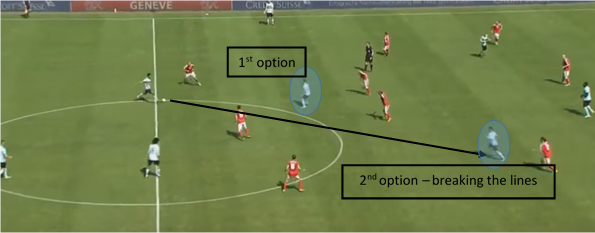
Similarly with the player in and around the final third, positioned further away from the ball. In this example, one of the strikers comes towards the ball and looks for gaps in between, whereas second one makes a run in behind the defenders. The opposition back line players have to choose whether they react to the first or second tempo movement what creates additional problem for them and possibly splits them up.
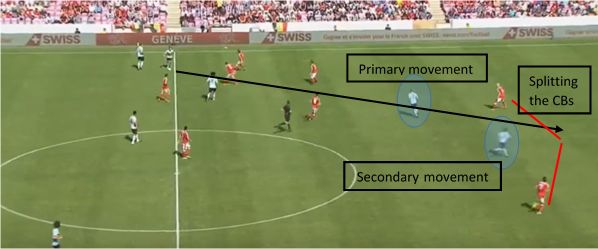
This kind of movement can be observed as well when the ball is already in the final third and around the penalty box. In this situation, striker might choose to move towards the ball, dragging two defenders with him (first tempo movement), whereas, at the same time, one of the midfielders might run in behind the opposition back line (second tempo movement).
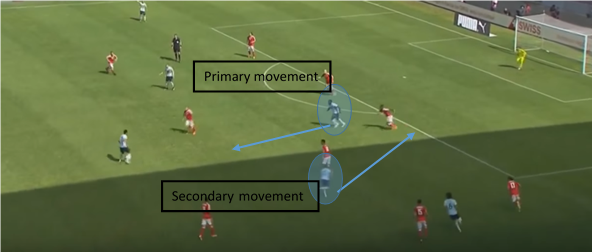
‘Second tempo’ movement does not neceserarily have to be a pass, it might be the case of player on the ball dribbling into the space created by other players’ movement. For example, as the winger/central midfielder shows up down the wings (taking the defender with him), full back on the ball might choose to drive with the ball centrally into space left by the defender that has followed the winger/central midfielder.
[wpsharely id="2988"][/wpsharely]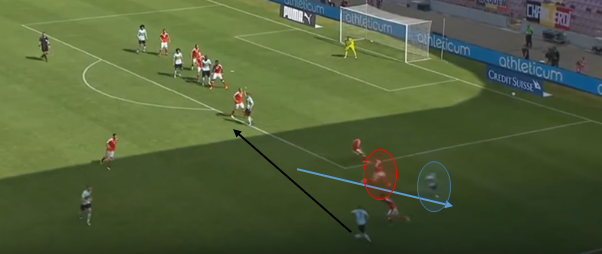
These kind of movements might be especially useful when the ball is crossed from the wings. ‘Second tempo’ run into the box is usually made into the back post and is slightly delayed so the defender is not ready. It is also often made into the space occupied by the full back, not central defender (which are occupied by ‘first tempo’ run made by the striker).
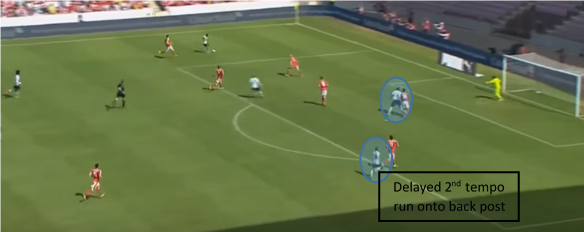
Playing beyond ‘first option’ requires great deal of tactical awareness and game experience. Player on the ball should be able to recognise movements away from the ball, whereas players off the ball should be able to recognise each other’s movements and react off the triggers.
By Alex Trukan, Development Coach, Nottingham Forest
@AlexTrukan


